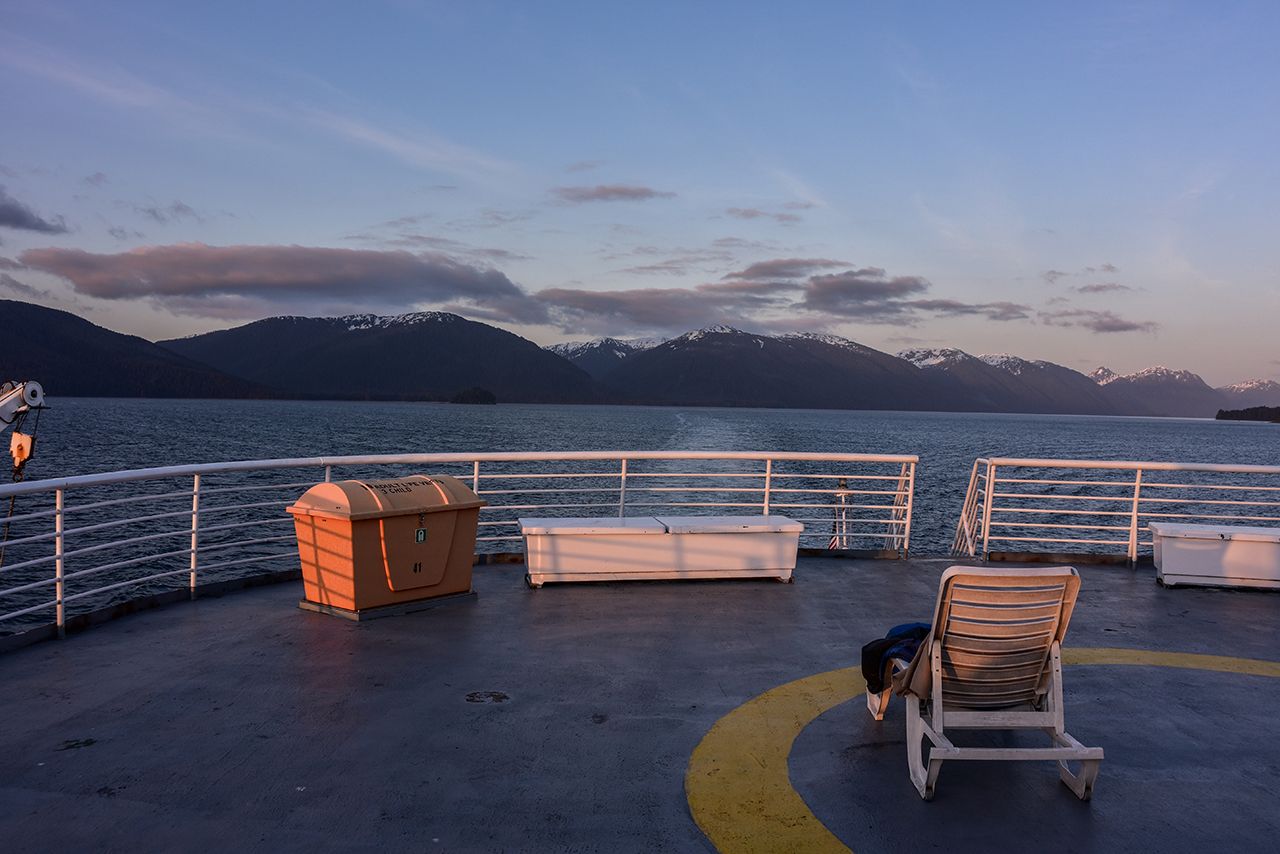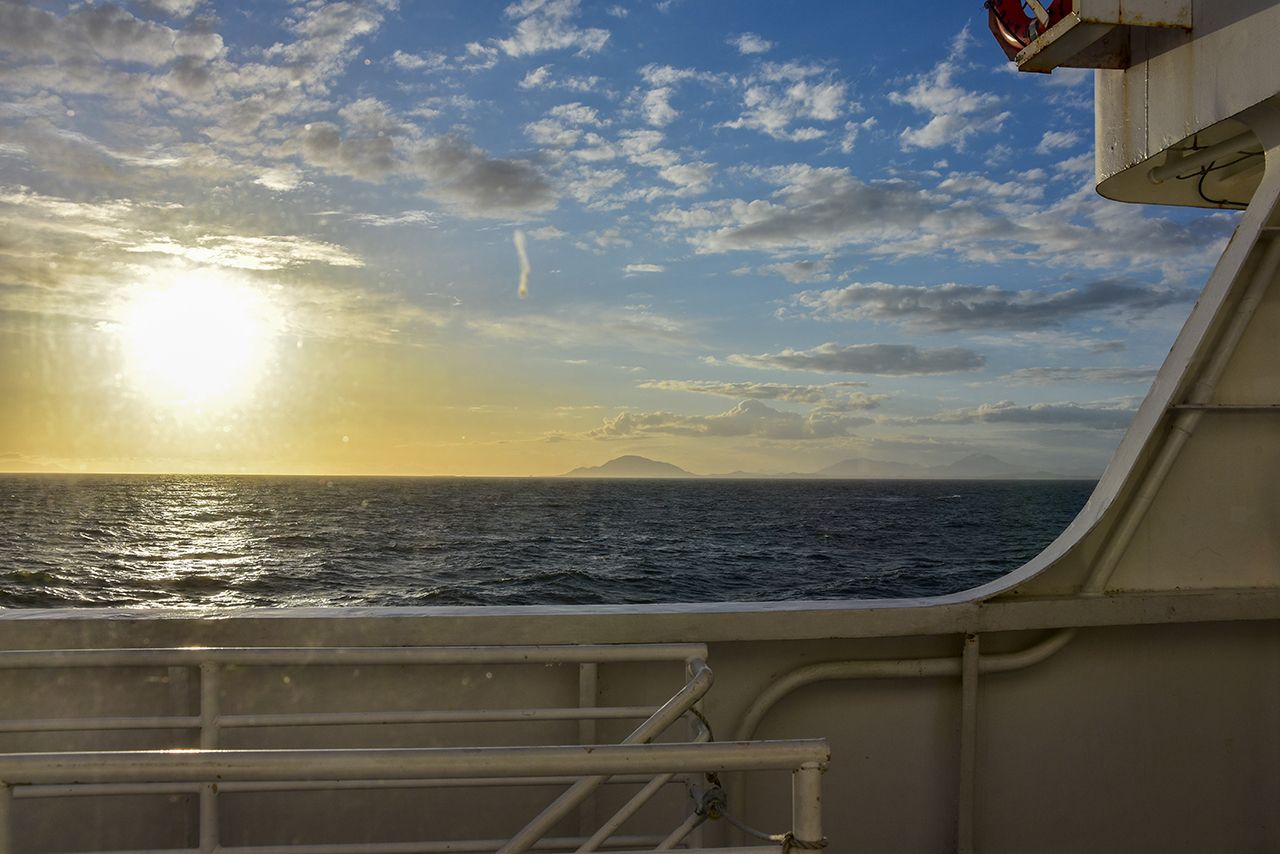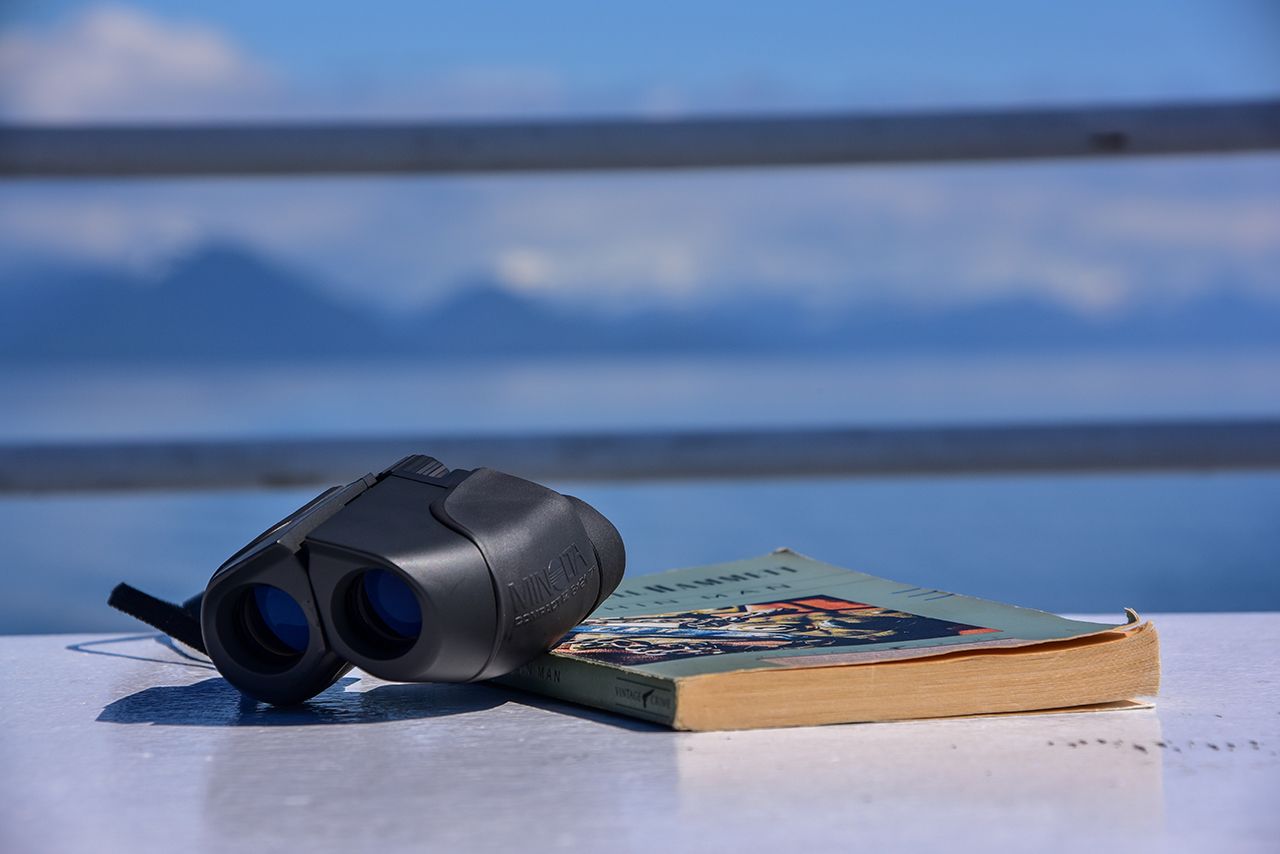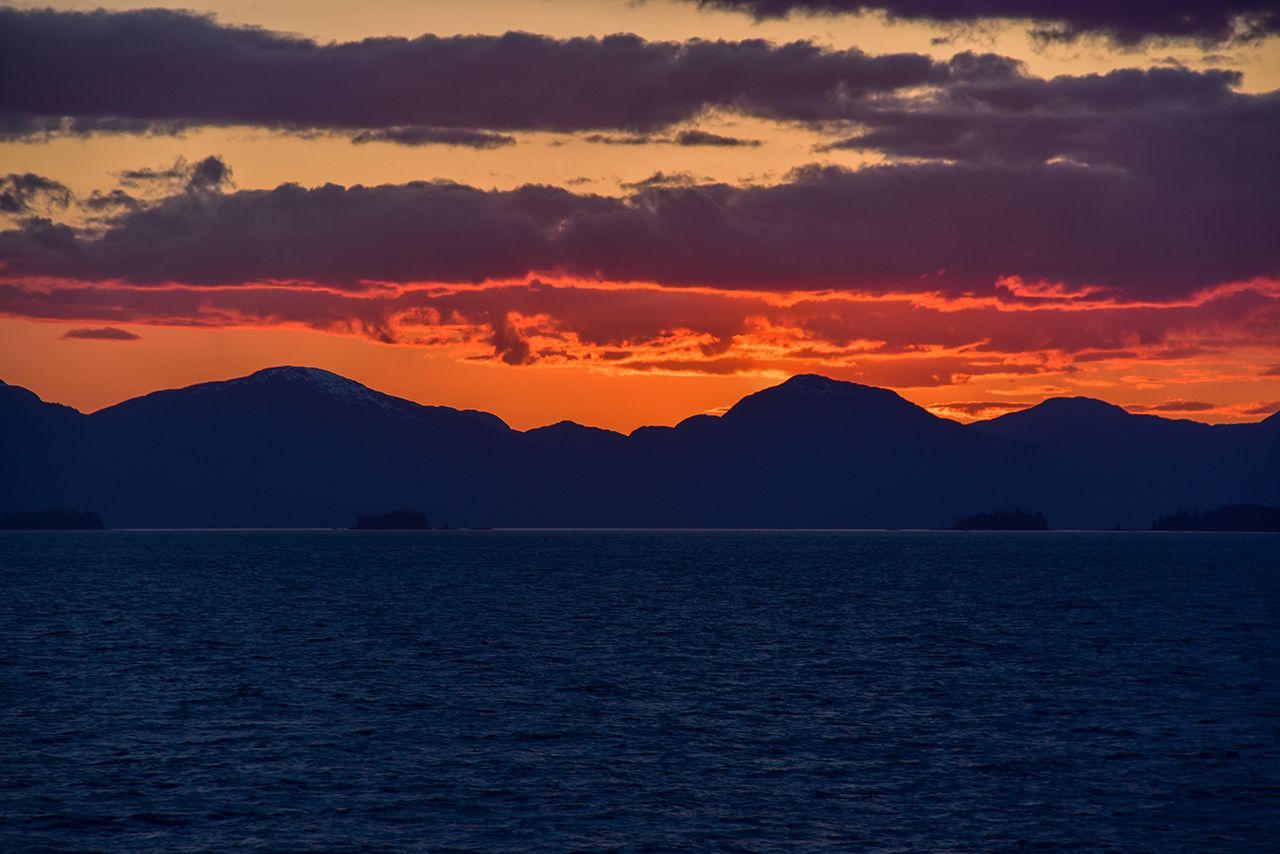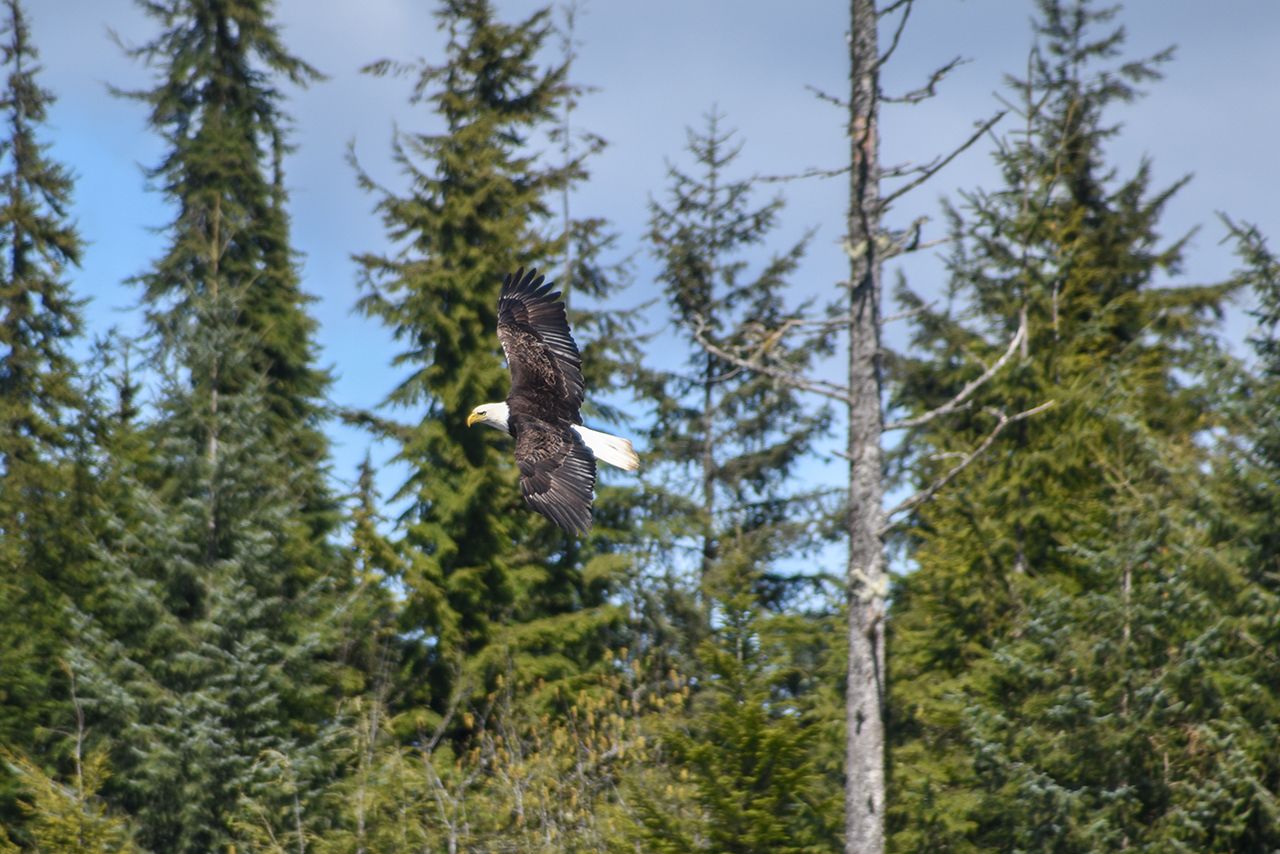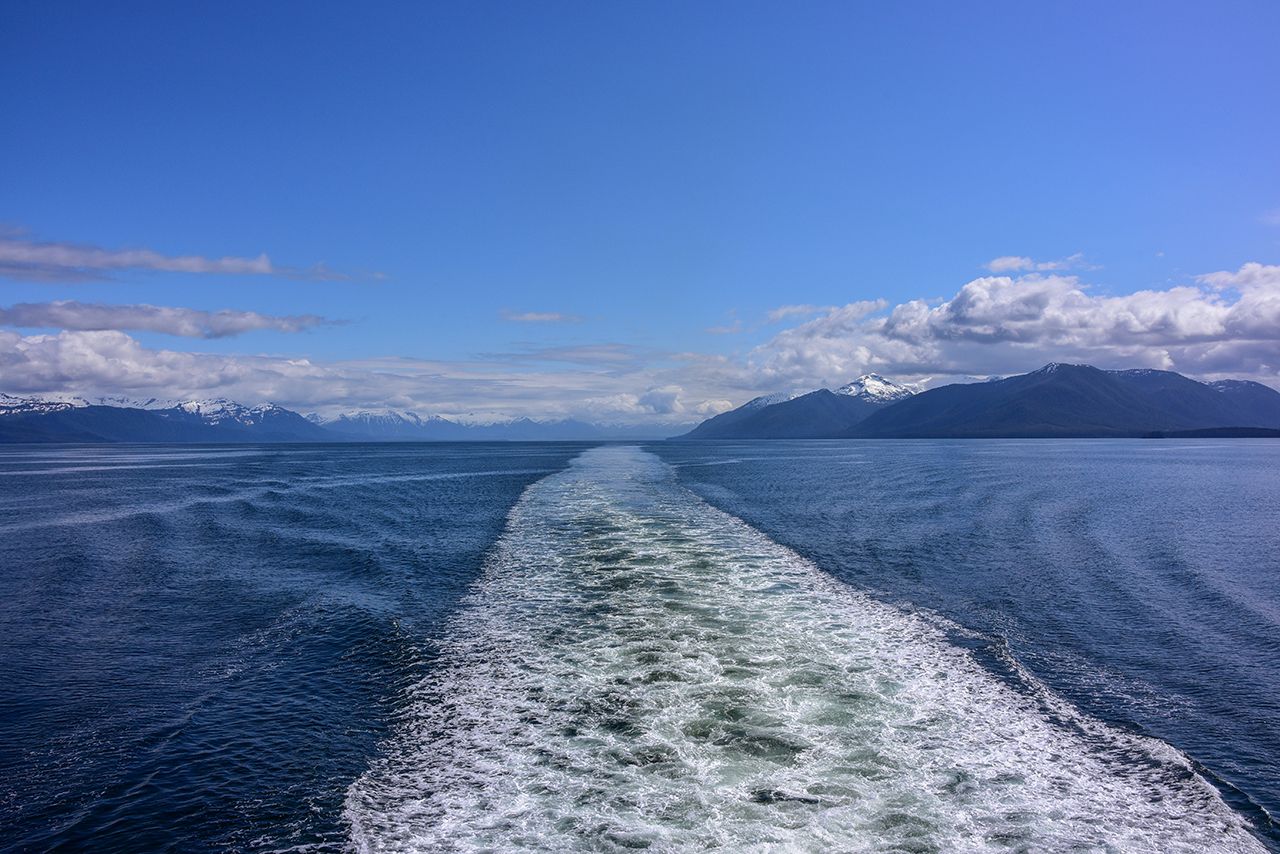KAKE, ALASKA—It’s at the precise moment I begin to write these very words—to start recording my whiny notions about why it’s impossible to spot bears along the Trans-Canada Highway all by yourself—that I spy a giant bald eagle out of the corner of my eye, spreading its wings in full, American glory. I find myself absentmindedly typing while my eyes scan the sky in search of a second, and quickly, a third bald eagle.

Notes From the Alaska Marine Highway System
I’m sitting in the front lounge of the M/V Matanuska (M/V standing for motor vessel), which is currently docked in the small, Alaskan seaside town of Kake—accessible only by a small airport, and the public ferry (hence today’s visit) which will eventually take me to Juneau, Alaska’s Capital City, and my home for the coming summer.
I’m the only person sitting in the lounge, which has an eerie, desolate feel to it. It’s Saturday afternoon, and we’ve enjoyed a glorious spring day filled with sunshine, a chilly breeze, and a curious dearth of animal sightings—until I see the bald eagles out in full force.
If you’re wondering why I’m not spending this perfect afternoon out of doors, well, that’s because I’ve spent the better part of the past twenty-four hours gazing off at the snow-capped mountains abutting the coast of southeastern Alaska, including a restless night splayed out on a lounge chair, tucked snugly inside my sleeping bag, under the dim heat of the solarium lights. Having paid a cool $400 to ship my car to a city without any roads, I was loathe to drop any additional money on a cabin for myself—this was an opportunity to commune with nature, was it not?
Yet the fore lounge (cue nautical descriptions) is not the worst place to be, either. There are a few dozen chairs scattered in front of the floor to ceiling windows, which are bolted into the floor, of course, in case of stormy weather. I’ve taken up temporary residence in a cluster of chairs towards the port side, affording me a gorgeous view of the day’s route, and currently, the small dock around which the eagles are circling.
I can comfortably sit and type these words, and watch America’s National Bird scrap with another kind of falcon, or eagle—who knows? Over what appears to be the rotting carcass of a fish any angler would be damn proud to bring home. I suppose I’ll come to know these things over the coming weeks.
The Alaska Marine Highway System, which operates what I’ve taken to calling the Poor Man’s Cruise Ship—aka the M/V Matanuska—presents an unusual set of circumstances for its passengers. Unlike a Rich Man’s Cruise Ship, where everyone embarks at the same port of origin and disembarks at the same port of departure, the ferry makes any number of stops along a route that stretches all the way from Bellingham, Washington to Dutch Harbor, Alaska (a port town in the Aleutian Islands). The ride presents ample opportunity for me to see the sights of the Alexander Archipelago while not moving all that much. Kind of like a cruise ship.
Last night, we pulled into Ketchikan at 11PM, and those who were so inclined had an hour to duck into town and poke about, so long as they were back on board by midnight. The ferry leaves with or without you.
Yet aboard the M/V Matanuska, there isn’t all that much to do, aside from pace about the deck, peer through a set of binoculars, or photograph the coastline. Inevitably, the brisk wind will drive you indoors, where you’ll find yourself grazing about for a way to occupy yourself.
You feel as if you should spend this time doing something meaningful—thinking deep thoughts, or having deep conversations—but you aren’t exactly sure how. You aren’t the only one with this conundrum—there are many passengers pacing around, nodding in assent to one other, but unable or unwilling to begin any sort of meaningful dialogue.
This is compounded by the fact that the “cocktail lounge” has been homesteaded by a young girl, eight or ten years of age, who had made herself quite comfortable—splaying out books, snacks, and blankets clearly thieved from the den at home. She’s not the only one to carve out a small slice of the communal area for herself; poke about all of the lounges and you’re bound to find folks of all ages curled up in balls at any time of day, watching movies, reading books, and catching up on ZzZ’s.
Needless to say, the cocktail portion of this lounge is all boarded up, and libations are impossible to come by. Time stands still on the M/V Matanuska, and there appears to be a commonly acknowledged public awareness that when it comes to entertainment, everyone is on their own.
I suppose this is the point at which most correspondents will regale you with a tale or two about a deep, meaningful interaction they had with a complete stranger, preferably under a starry night sky, or after having seen a killer whale breach from the deep.
Yet there will be no such story from me; I endeavor to spend my one day, eighteen hours, and fifteen minutes aboard the M/V Matanuska in complete and contented silence.
As a self-diagnosed ambivert coming from a week-and-a-half visiting home in New York, followed by a frantic, four-day drive from Denver, Colorado to Prince Rupert, British Columbia, where I was catching the ferry, I’m perfectly happy to stroll about the decks with my camera, binoculars, and Dashiell Hammett’s The Thin Man in hand, constantly on the lookout for whales that may or may not be swimming in these waters. As a matter of fact, that’s a good question. What kind of whales do swim in these waters? I’ll soon find out, I suppose.
Perhaps it’s a good time to talk a bit about why I’m off to Juneau. I’m heading up North for the summer to work as a Naturalist Photography Guide for Gastineau Guiding, a small company based out of Juneau, where I’ll be taking people on hiking and whale watching trips, and teaching them how to take pictures of it all—an experience which leaves me periodically giddy with delight that this cruise is essentially what I’ll be doing all summer, albeit with far shittiter weather, and much more responsibility.
There will be a lot to learn, especially if I don’t yet know that it’s indeed Killer Whales, though more often Humpbacks, that roam the waters of Southeast Alaska. I’m excited about what’s to come, but also a bit apprehensive. Guiding others in a place that I’ve never been, being responsible for teaching them all about the land, the people, and the animals? Well, at least I can show them how to take a cool photo of it all…
But there’s nothing I can do about it now. For the time being, I’m content to let my mind wander, and process the lengthy drive of the past few days, a mad dash from Colorado to Western British Columbia, affording me almost no time to engage in any traditional “travel” activities, which for me, consist mainly of thinking, photographing, and reading & writing.
There are two things that I noticed soon after entering Canada—first, that not every gas pump had an auto-lock feature on the nozzle, apparently a uniquely American feature that I never before appreciated, which allows you to engage in the much-needed cleansing ritual of a road-trip-vehicle that occurs in the 60-90 seconds while your car is filling up with gas, wasting not a minute of your stop at a random gas station. Simply writing that sentence makes me realize how much of a neurotic New Yorker I can be.
The second thing I noticed upon entering Canada is that the speed limit signs, as well as all other forms of measurement, are written in the metric system, limiting you to an agonizing 110 km/h, a major blow to any feeling of progress after steaming north on US-15 at the state-sponsored speed of 80 MPH, or roughly 135km/h. All signs are also written in French. Apart from these two facets of multiculturalism, Canada is otherwise indistinguishable from the central states bordering it (Montana, North Dakota, etc.).
KM/h; this I was prepared for. The young attendant manning the entrance to Banff National Park greeting me with a kindly bonjour, I was most certainly not, and I responded with a jumbled, “ummmmmm…..do I need a Park Pass to get to the town of Banff, or can I just drive through?” Fortunately for me, the attendant replied, in perfect English, that Canada was celebrating its 150th anniversary, meaning my admission fee to Banff, as well as any other Canadian National Park I visited that year, would be waived in celebration of Canada.
In Canada, things are very much…the same as they are in the U.S. Aside from a few oddities involving the use of credit cards (the use of a PIN for international users, a capability I wasn’t aware of until phoning Barclays support staff in the prepared foods aisle of a supermarket outside Lethbridge, British Columbia, as well as the need to sign for all purchases under $10, a painstaking use of time that us Americans will happily risk all sorts of identity theft to avoid) pretty much everything is in Canada as it is in America.
But for the painfully slow speed limits, both on highways and in town limits—you are often required to slow to 50, 40, or even 30 km/h along the Trans-Canada highway while approaching even the smallest of towns, unworthy of even a gas station—many Americans from the coast would have a similar dose of culture shock should they find themselves in Western Montana.
Except for the whole French-signage thing. To my knowledge, it’s only the Quebecois that speak French, yet here we are, thousands of miles, ahem, kilometers away from the capital of that fine state, Montreal, and everything, including my package of Ramen, has the French phrasing labelled underneath the English. For the most part, it’s an exercise in entertainment, such as the listing of “Canyon Banff” underneath “Banff Canyon”—I suppose a lawfully necessary, if not sensibly unnecessary designation.
**All of these prescient observations were recorded by your correspondent over the course of a somewhat agonizing, 35-hour trek through rural Canada.**
If you speak with anyone who has driven to Alaska, rest assured that they will regale you with tales of all the animals they’ve seen—four moose, six bears, a number of birds they’re unable to definitively identify, a fox, and a reindeer—or was it a caribou?
It’s a certainty you will hear this count, and if you’re lucky, you’ll even get to see their grainy, zoomed-in cell-phone image of the head of a moose blocked by an out of focus tree branch, taken from the window of their car as they’ve pulled over to the side of the road.
If it sounds like I’m bitter, in a way I am—to see all the wildlife the roadside has to offer, you need someone whose job it is to find this wildlife. You need a spotter. You need someone who is not responsible for piloting your two-thousand pound vehicle around windy, curving, oftentimes slick roads. You need someone to say there! At the side of the road, up ahead, is a black bear….and you need to have not another car in sight as you pull off and roll down the windows for a closer look.
It’s this note that I was bitterly recounting at the top of the hour, when my own eyes were distracted by the bald eagle right outside the window of the M/V Matanuska. Sometimes, it pays to have another person drive.
I only saw two animals during my entire, 2,000-mile drive to Prince Rupert, both of them black bears, both of them at the side of winding, curvy, slick roads, and both times with a car following my tail closely. Hardly situations where I could have pulled off to get what I could only hope would be my own tree-obscured shot of the little critters. If it sounds like the trip to Prince Rupert was a slog, well, in a way it was.
Which makes me all the happier to be sitting in the lounge of the M/V Matanuska, gazing out the window and basking in the sun, keeping my eye out for whales, yet finding mostly eagles, and the odd Dall’s Porpoise (commonly mistaken for a killer whale). It’s my turn to be the spotter, and keep an eye out for the wildlife, and when it comes to simply watch—or take a photo of it.
Soon enough, I’ll find myself as the guide on trips like these, the one in charge of steering the proverbial ship in the right direction, likely with little opportunity to stop and gaze at the wildlife.
The glacial pace of the ferry, a bonus for those prone to seasickness and wildlife watchers alike makes for a surprisingly pleasant ride, considering the cost of the ticket, and my plan is to enjoy all forty-two hours of it. For me, the weather makes all the difference: this same trip can easily be an absolute nightmare, should you be trapped inside by pelting rain and rocked to and fro by rough seas. Camping on the aft (rear) deck would not be comfortable.
Yet on a clear day, where you can observe the curious phenomenon of blue skies above the open sea, while the coastal mountain ranges are ringed with dark, wispy clouds, the passengers aboard the M/V Matanuska have not a care in the world. It’s time to sit, back, read a novel, and take a moment to enjoy life and whatever compelling circumstances allow you to gaze at the Alaskan mountain ranges in the distance—even if the closed cocktail lounge means complete strangers can’t engage in a familiar, five-o’clock call-to-arms.
